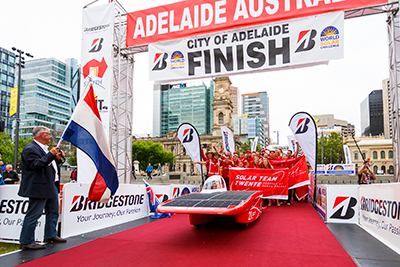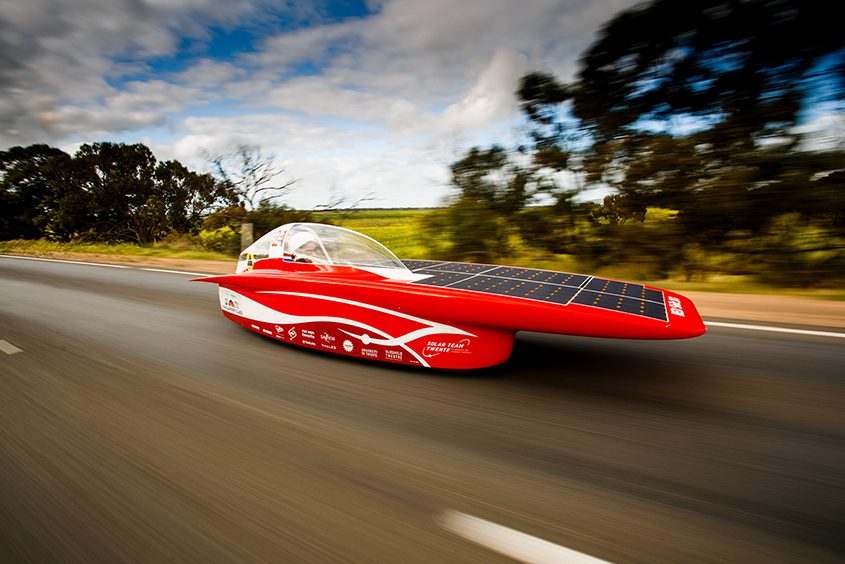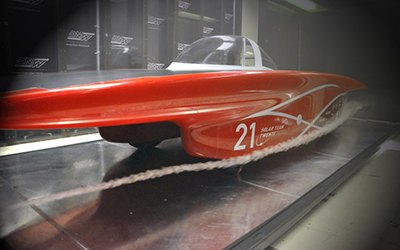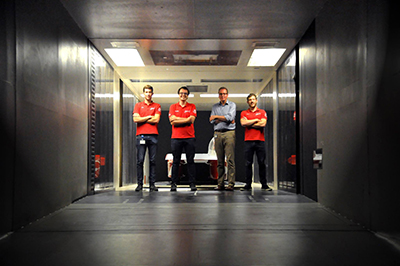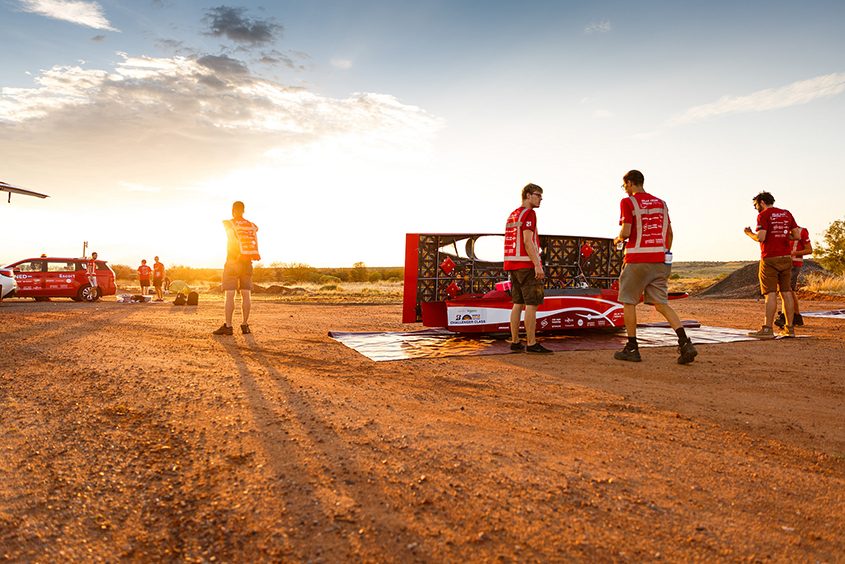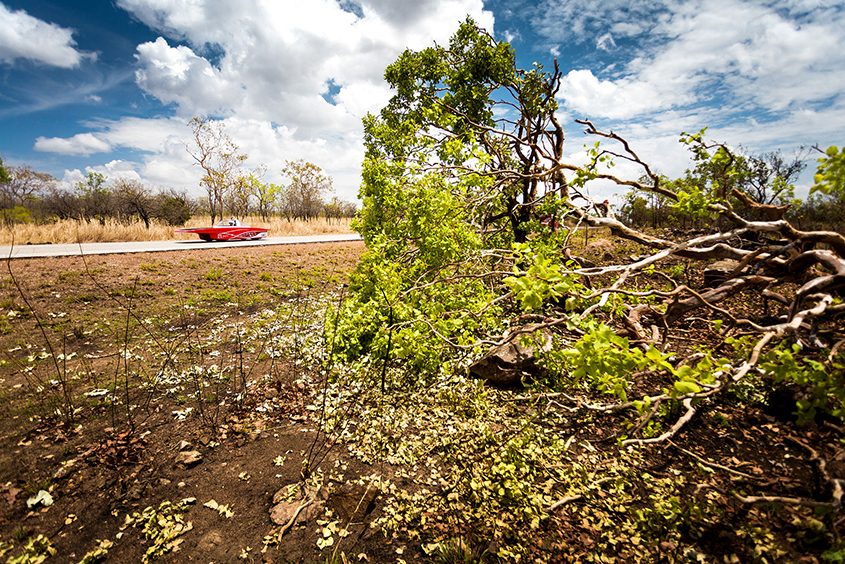Students and businesses often complement each other effectively. That certainly applies to the Bridgestone World Solar Challenge in Australia, an event involving solar-powered cars held every other year. One of the regular race participants is Solar Team Twente, consisting of students of the Saxion University of Applied Sciences and the University of Twente. NLR plays a modest background role in developing the solar car by lending a helping hand in designing the structural parts and aerodynamic shape, and in the ultimate construction and finishing of the composite bodywork parts.
The Twente team again reached the upper levels of the classification of the World Solar Challenge in October 2017, although after being penalised thirty minutes they finished fifth instead of third overall. Although winning is of course fun, it is not the most important task in this particular race. Besides fostering awareness of solar power and mobility among the public at large, working on a solar-powered car offers a wealth of hands-on experience that simply cannot be provided by theoretical education alone.
The students, with a few mentors from the team from the previous challenge, were thrown in at the deep end to design their own solar car, using existing and new techniques to comply with the ever-changing race rules and come up with a car that would get to the finishing line. The basic design requires thorough knowledge of aerodynamics, which ultimately leads to building with composite materials. In both fields, NLR has a lot of in-house knowledge and also possesses facilities usable by the students.
Challenge: design the most aerodynamic car
The team began with the design. The support provided by NLR consisted mainly of aerodynamics know-how. To avail of this support, several team members worked alongside Hans Maseland of the Flight Physics and Loads department. It was his first time cooperating with the students and he enjoyed it very much. “The goal is very clear and the students already possess extensive knowledge and experience thanks to the mentor system,” says Maseland. “What’s more, the aviation industry is currently working on the same thing, the development of wing profiles made of composite materials to make better use of the laminar flows, because there are no longer any rivets to disturb the airflow.” In fact, the car developed by the team is a refined aircraft wing of which the composite parts were made at NLR’s site in Marknesse, under the watchful eye of Senne Sterk and Joachim de Kruijk of the Structures Technology department.
NASA wing profile provides basis
The design phase from September to January meant there was only a short time to come up with the perfect aerodynamic design that would satisfy the annually-changing rules of the World Solar Challenge. This year, the maximum number of solar cells was greatly reduced, so the surface of the car also decreased drastically.
In design terms, a smaller car also poses another problem. The design process started with a classic NASA wing profile, the most logical design for a car of this shape and size. This is evident when you see that all the cars of the entrants looked very similar. Even the slightest change can mean the difference between winning and losing. But a wing profile does have a disadvantage: it has the tendency to want to take off when close to the ground.
When designing the car – or the wing in fact – NLR’s expertise comes to the fore through its contributions to technological developments that reduce air resistance by 5 to 7% by utilising laminar flow instead of turbulent flow over the wing. This same effect can be used for the car on the underside of the wing, where the biggest gain can be achieved. The topside will always be affected by turbulence, because this is where the solar cells are fixed and they cause a turbulent flow due to their unevenness.
“Nothing was symmetrical anymore”
Then came the next challenge: fitting the wheels. NLR’s expertise was particularly useful here, says Jeroen Minnema, one of the team’s designers involved with the aerodynamics. Maseland was indispensable in thinking through the small details. “Thanks to Hans, nothing was symmetrical anymore,” says Minnema.
For example, the car was designed to slightly resemble a catamaran, with one hubcap coming closer to the ground than the other so as to reduce the downward pull of the car, which in turn provides extra rolling resistance. Maseland also came up with the idea of having two bulges at the front below the nose, thus slightly slowing down the flow of air before it enters the ‘tunnel’ below the car. “We’re not certain it worked properly in practice, but without Hans we would never have thought of this,” says Minnema.
Testing the Red Shift in the DNW wind tunnel facility
Solar Team and Hans Maseland
But the biggest challenge of all was the canopy where the driver, or rather pilot, sits. Maseland admits he was impressed by the student who designed the canopy. “This guy worked on the design for three weeks straight. He wasn’t interested in the Christmas holiday, it simply had to be right for all conditions, including possible crosswinds.” Subsequently, the design was tested in the wind tunnel at Marknesse, where this time the entire car squeezed into the tunnel because it was smaller than previous versions.
A point worth mentioning is that all Dutch teams, including the Nuon Solar Team and the Eindhoven Solar Team, were given wind tunnel time at Marknesse to test their cars. And the tests are important, according to Maseland. “It’s all about the final two percent of air resistance, the final fine-tuning in the wind tunnel, which includes examining the influence of crosswinds.”
Learning from each other
But before the car could go into the wind tunnel, it was necessary to build the bodywork parts. This process involving the use and incorporation of composite materials was supervised on behalf of NLR by Senne Sterk and Joachim de Kruijk. Two students spent four weeks in lodgings close to Marknesse to be able to devote as many hours as possible each day to laminating and modelling the fuselage shapes over moulds that the students had made earlier in Enschede.
Asked whether the students benefited a lot from NLR’s expertise in composite materials, Sterk pointed out that the students already knew a lot themselves. “The big advantage is obviously that in our workshop they can ask us anything, because we have people working here who have loads of specialised knowledge and experience,” he says. Edward Everts of Solar Team Twente said: “At one point we found the pack had a leak, and Rémon and I were unable to find it. Senne walked around it and heard exactly where the hole was, even though it was really tiny.”
As NLR has been working alongside successive Twente Solar Teams since 2009, nothing much unexpected happens, not least because the students are now far more proficient in such matters as planning and the transfer of knowledge via the mentor system. But there are still some things that require that little bit of extra experience, says Sterk. This applies particularly to the structural design of the composite parts and how the design influences the production of those parts. During the conceptual phase there were several design sessions where the students could discuss their questions about composite structures with NLR. Different design options were examined and weighed up in terms of performance, material choice and incorporability. By way of example, he mentioned the fastening of the pedals to the chassis. The problem here lies in the use of different materials, such as metals, and drilling through the sheets. “It has to be as light as possible and it’s not wise simply to hammer a bolt through a sandwich sheet,” says Sterk.
Another recurring problem that crops up every two years is the ‘roll bar’: a frame that protects the driver if the car turns over. “The question that arises every time is: should we make it using composite materials or aluminium? As a roll bar made of composite has numerous consequences for the design, especially in terms of safety, we invariably decide not to use it,” says Sterk. “Often the design is unsuitable for integrating a safe and simple composite roll bar. The slightly heavier weight of an aluminium variant has a negligible effect on the car’s performance, because the aerodynamics are what really count. So the roll bar is again made of aluminium.” The composite work for the Twente team is not challenging for NLR, but it can lead to a student suddenly seeing something worthwhile in composite materials. Sterk was once himself a member of the Formula Student Race Team of Delft University of Technology, which is where he first came across composites. “It was only after that experience that I decided to get into composites!”
Professionalism and drive
The students from Twente in any event found working at Marknesse an eye-opener. For one thing, their working days were much shorter but far more efficient. “That’s how you notice that it’s a professional workplace,” says team manager Olivier Berghuis. One challenge lies in overseeing them and transferring knowledge of matters they must keep an eye on. The workshop personnel are very important in that regard. They are the ones who work most with the students. The students spent four weeks with NLR at Marknesse. The team consisted of two new students and one from the year before. This latter point produces a big advantage, says Sterk. “The mentor is quickly able to familiarise the other two with what needs to be done and to get them going. The people in our workshop also help them, but thanks to the mentors they are sooner able to set to work unassisted.”
All NLR departments that worked with the students were very enthusiastic about their professionalism. The group was diverse and carefully put together: from talkers and doers to thinkers and researchers. There was a lot of experience, but even more enthusiasm and drive among the students and it’s very infectious.
NLR and Solar Team Twente
Solar Team Twente : Olivier Berghuis (team manager), Arne Kiel (Aerodynamic Engineering), Rémon Kalter (Mechanical Engineering), Edward Everts (Structural Design) and Jeroen Minnema (Aerodynamic Engineering & Race Strategy).
NLR: Hans Maseland (Flight Physics and Loads) and Senne Sterk and Joachim Kruijk (Structural Testing).
All photographs copyright Solar Team Twente
Keep exploring
Need to know more? Visit our Augmented and Virtual Reality capability page.

